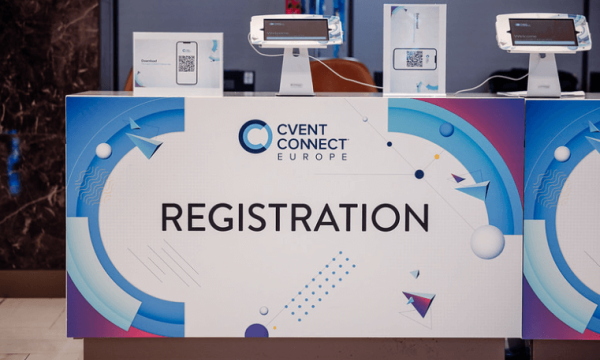Creating an inclusive event means ensuring a safe space for everyone. Whether your event is in-person or virtual, it’s crucial that attendees feel safe, both physically and psychologically.
And yet, according to the M&IT Sexual Harassment Survey and Report (2022), 50% of respondents had been subjected to some form of sexual harassment while working in meetings and events. Notably, 80% of event professionals believe we need a sexual harassment code of conduct for events.
Read on to explore 12 practical ways to create safer, more inclusive environments for attendees.
Why safeguarding your attendees matters
Looking after the physical safety of attendees is obvious, but it’s just as crucial to create an environment where individuals feel safe, respected, and valued.
Lasting reputational damage
Safety mishaps and adverse publicity can cause damage to your brand image and trustworthiness. Mending tarnished credibility is never a simple fix.
Should something happen at your event, some attendees may share it on social media. Usually, this happens when they feel the event organisation isn’t listening.
Impact on recruitment
Maintaining a safe and transparent environment for your team is crucial to retaining talent and introducing fresh strengths.
Gabby Austen-Browne, the founder of Diversity Alliance, directly links this to a shortage of talent in the events industry:
“I know for a fact that there have been people within this industry that have left the industry because of issues that have happened, and they’ve not felt supported.”
💡For more insights on safeguarding your events, check out this Cvent CONNECT Europe session:
Loss of attendees and revenue
If attendees feel unsafe at your events, they probably won't return or tell their colleagues about them. That means fewer people showing up, lower ticket sales, and ultimately loss of revenue.
The larger the incident, the more attention and negative publicity it will gather. This means potential attendees will think twice before returning.
Harm to attendees
If your safety measures aren't up to scratch, attendees could face accidents and injury. But you also need to be aware of the psychological impact that emotional distress can cause.
Legal liability
When attendees suffer harm, event planners and stakeholders can find themselves exposed to legal issues. If the harm resulted from negligence or inadequate safety measures, this could lead to lawsuits, legal expenses, settlements, and the possibility of substantial financial damages.
Decreased sponsorship opportunities
Organisations may be reluctant to sponsor or partner with events with a reputation for safety concerns or incidents. This can lead to losing potential sponsors, partnerships, and revenue opportunities for event planners.
12 practical ways to make your events a safe space
1. Establish a clear code of conduct
A code of conduct is a set of rules outlining expected behaviour and how individuals should interact. It promotes integrity, respect, and professionalism while ensuring compliance with laws and regulations.
Make sure your code of conduct spells out that any kind of harassment, like unwanted advances or offensive comments, means their immediate removal from the event.
Add useful notes to cover being respectful when you communicate, stressing the importance of listening to others and steering clear of using inappropriate language.
Lizzy Eaton, the Director of Oddity Events and Marketing, suggests clarifying the non-negotiables and zero-tolerance policies with our partners and suppliers to ensure everyone is on the same page.
2. Develop standard operating procedures (SOPs)
A standard operating procedure (SOP) is a set of instructions to standardise routine operations in an organisation. It ensures consistency, efficiency, and safety.
Start by creating a step-by-step guide for event staff on how to handle medical emergencies, including who to contact and where to find first aid supplies.
It's worth creating a protocol for addressing disruptive behaviour, outlining steps for de-escalation and when it's appropriate to involve security personnel or local authorities.
3. Work with venues and suppliers
Working with your venues and service providers can improve the safety of your events.
For example, ensure that all venue entrances and exits are well-lit and accessible to reduce the risk of accidents or incidents in dimly lit areas.
Work with suppliers to ensure food and beverage options are clearly labelled with allergen information to prevent allergic reactions among attendees.
4. Train staff and volunteers on safeguarding
Ensuring staff are well trained on safeguarding processes is a critical piece of the puzzle. One way to do this is by conducting role-playing exercises during training sessions. Simulated scenarios like how to assist someone in a medical emergency will ensure staff are prepared to respond efficiently should these situations arise.
5. Implement security measures
Here are a couple of suggestions to make sure your security is effective.
You could consider hiring security personnel to conduct bag checks at entrances, to ensure no prohibited items, such as weapons or alcohol, are brought into the event.
Depending on the size of your event, you may want to consider using security cameras to monitor crowd movements and quickly identify any potential security threats or disturbances.
6. Create designated quiet/low sensory spaces
Attendees with disabilities or neurodivergent attendees may have some needs that should be part of your event plan.
For example, setting up a quiet lounge area where attendees can take a break from the noise and crowds can be helpful.
7. Prioritise inclusivity
Inclusivity should be treated as a natural part of every event. Look into helping attendees with mobility challenges, ensuring they can easily access the venue.
Provide translation services or multilingual signage. This will accommodate attendees who speak languages other than the primary language of the event.
8. Manage alcohol consumption
Serving alcohol at corporate events comes with risks, such as increased liability, possible bad behaviour, and damage to the event’s reputation.
You could implement a drink ticket system where attendees receive a limited number of drink tickets upon entry. This can help prevent overconsumption of alcohol.
Offering a selection of non-alcoholic beverage options at bars and refreshment stations is great for attendees who choose not to drink alcohol.
9. Regularly review and update policies
Out-of-date policies can lead to problems when they are no longer as effective. After each event, gather feedback from staff and attendees. Find out what they think about how effective your safety procedures are and use this to revise and improve your policies for future events.
Industry best practices are constantly developing, and new safety technologies emerge all the time. Keep your finger on the pulse of what is new and regularly update your event safety policies to include.
10. Work with local authorities
Local authorities are key partners in running successful events, so it’s important to keep in close touch with them.
For example, if you work closely with local law enforcement to develop a comprehensive security plan for the event, it will produce the best results. This could include coordination on crowd control measures and emergency response protocols.
Establish a direct line of communication with local emergency services. Give them detailed information about the event venue and access points. This will speed up their response in case of emergencies.
11. Communicate safety information
Including safety information in event materials such as programmes or brochures is crucial. Highlight things like emergency exits, first aid stations, and any other important safety features of the venue.
Using digital signage or screens located throughout the venue can also be effective in displaying safety messages.
12. Seek feedback and listen
If you want your events to succeed, it’s worth paying attention to feedback. Here are two ways to do that.
Firstly, send out post-event surveys to attendees, asking for feedback on their safety experiences and suggestions for improving safety measures at future events.
Also, hold debrief meetings with staff and volunteers after each event to discuss any safety incidents or concerns that arose. This is a good opportunity to tap into the group and brainstorm solutions for addressing them in the future.
Safety and inclusivity create the environment for event success
When safety and security are prioritised at events, attendees and planners get the most out of the experience.
Making safety and inclusivity a key element of your planning is not just the right thing to do, it also brings tangible benefits to your bottom line.
Safety and inclusivity are essential components of outstanding in-person events. Download The Ultimate Guide to In-Person Events to find out more.







